Understanding Cat Toys: What Every Owner Should Know

Cats are playful and curious animals, and like humans, they need stimulation to be happy and healthy.
Among the best ways you can keep your cat both mentally and physically active is by introducing them to a variety of cat toys.
But with so many choices available in the market today, how will you know which one will suit your furry friend?
In this article, we will delve into the world of cat toys: their importance, the types available, and how they contribute to the well-being of your cat.
This guide will help both new cat owners and those looking to enhance their long-time feline companion’s life by understanding everything about cat toys.
Table of Contents
The Importance of Cat Toys for Your Feline’s Health
When you think about cat toys, an image of a tiny ball or some feather on a string might come to mind, but cat toys serve a much bigger purpose than just play.
Cat toys are significant for the overall health of your cat, both physically and mentally.
Regular play helps cats expend energy, challenges their minds, and keeps them away from undesirable behaviors caused by boredom.
Let’s delve a little deeper into why cat toys are so important for your feline friend.

Why Cats Need Toys for Exercise
Indoor cats, in particular, lack the natural outlets for exercise that outdoor cats have.
Without cat toys, your cat may become bored, lethargic, or even overweight due to inactivity.
Regular play sessions with cat toys stir up their natural instincts to jump, run, and pounce, just as they would in the wild.
This helps tone muscles and supports healthy weight maintenance.
Plus, it’s a great way to bond with your cat while encouraging them to stay active.
- Helps prevent obesity through daily exercise.
- Engages natural hunting instincts, keeping cats active.
- Improves coordination and balance through play.

Mental Stimulation: How Cat Toys Engage the Mind
While physical activity is crucial, mental stimulation is equally important.
Cats are highly intelligent creatures, and without sufficient mental challenges, they can become bored, leading to destructive behaviors.
Interactive cat toys, puzzle toys, or toys that move unpredictably can stimulate their brains.
These toys encourage your cat to think, solve problems, and use their instincts in creative ways, reducing stress and anxiety.
- Relieves boredom, minimizing the possibility of misbehavior.
- Encourages problem-solving skills with puzzle toys.
- Reduces stress and anxiety by stimulating the mind.
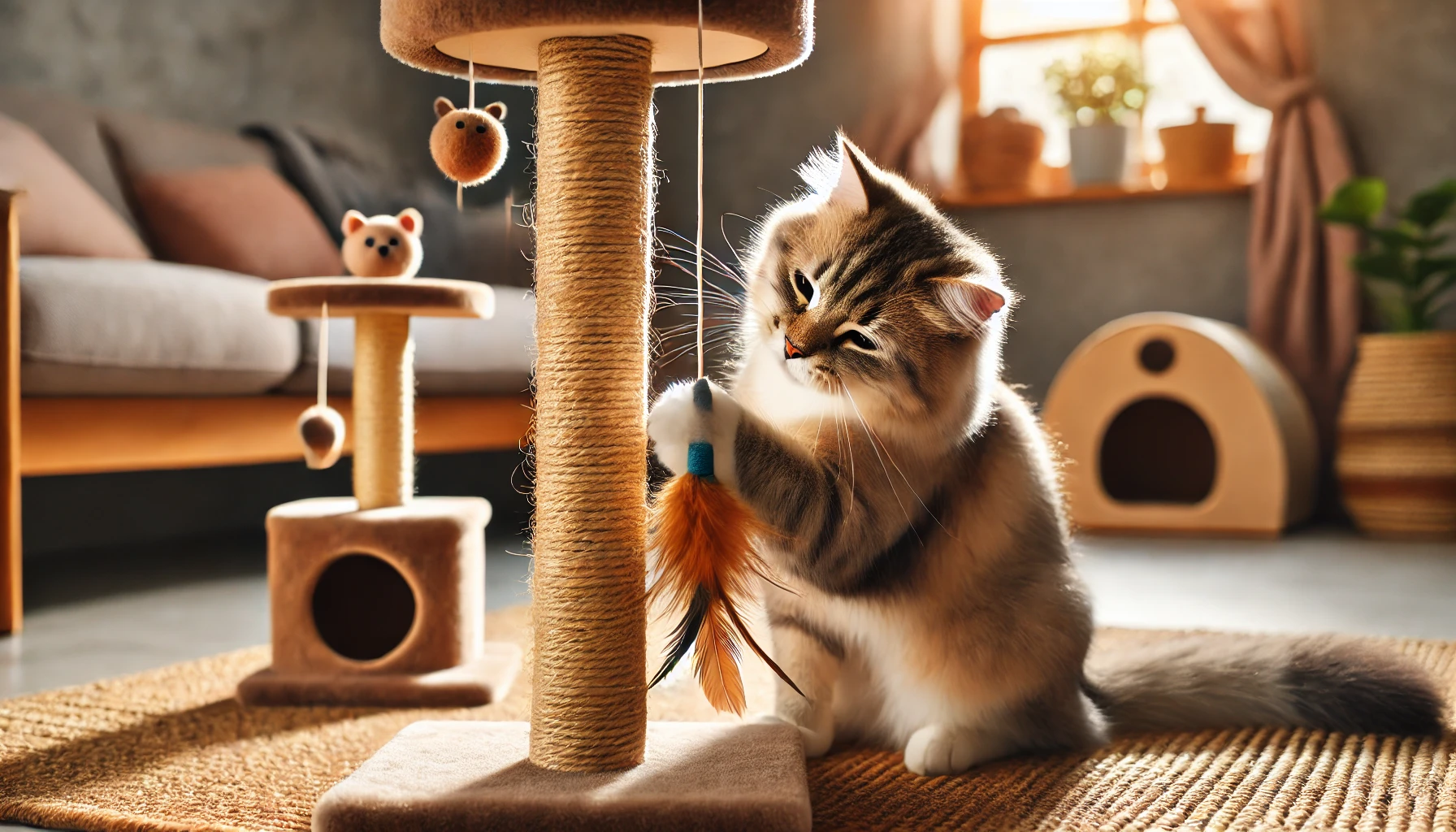
The Role of Toys in Preventing Behavioral Issues
Have you ever noticed your cat knocking things off the counter or scratching the furniture?
These behaviors often stem from boredom and a lack of stimulation.
Cats need outlets for their energy, and cat toys provide the perfect way to release pent-up energy and avoid these unwanted habits.
By regularly engaging your cat with cat toys, you can prevent them from developing destructive habits like excessive scratching or biting.
- Helps decrease destructive behaviors such as scratching or biting.
- Provides a healthy way to release energy and frustration.
- Prevents behavioral problems caused by boredom.
Cat toys provide essential physical and mental stimulation for your feline friend, reducing the risk of boredom and health issues.
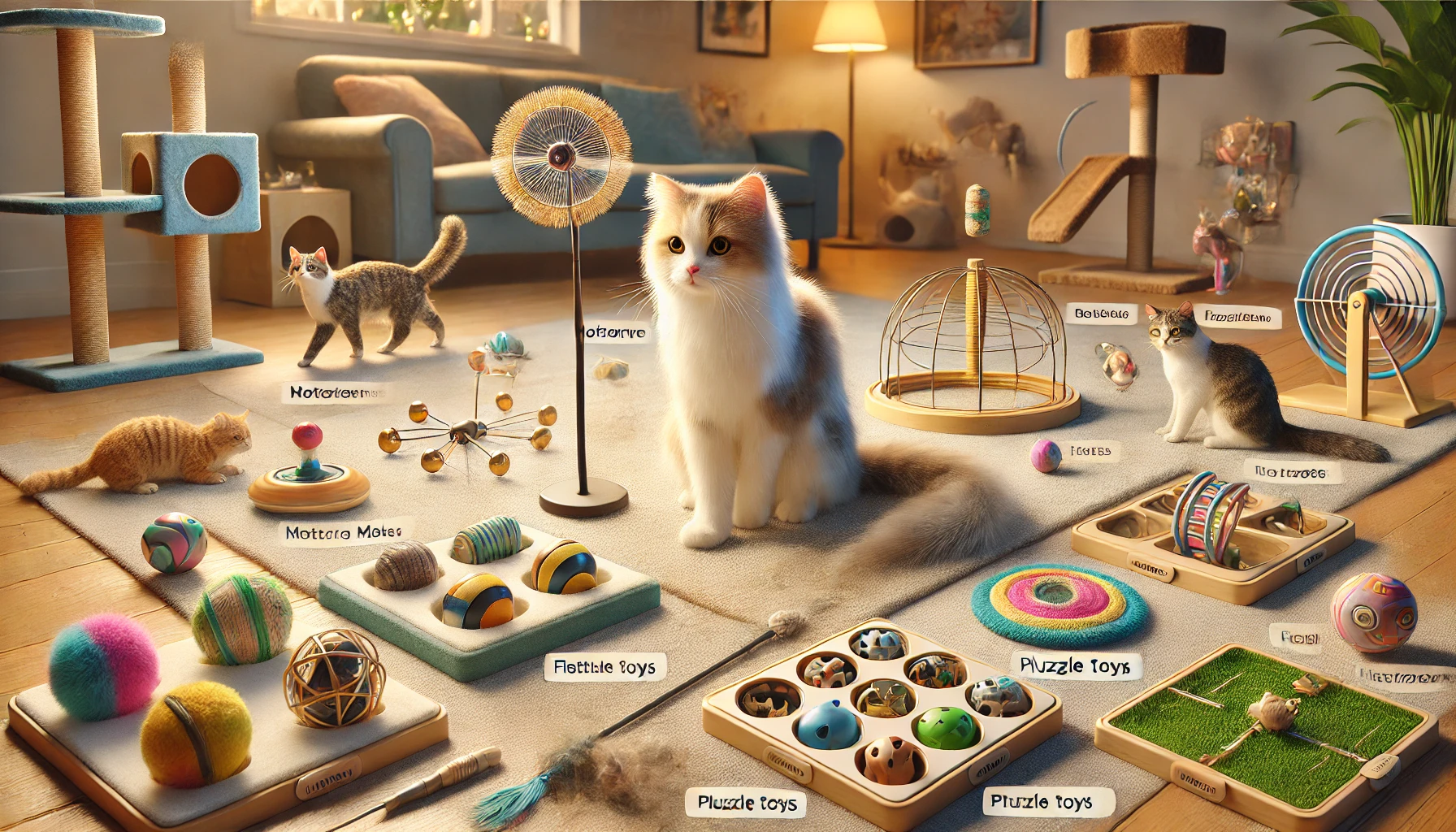
Types of Cat Toys: Which One Suits Your Cat?
There are many types of cat toys, all designed to suit different personalities, play styles, and energy levels.
By understanding your cat’s preferences, you can choose the right toy to keep them mentally and physically stimulated.
Let’s explore some of the most popular types of cat toys available today and how they can help satisfy your feline friend’s needs.
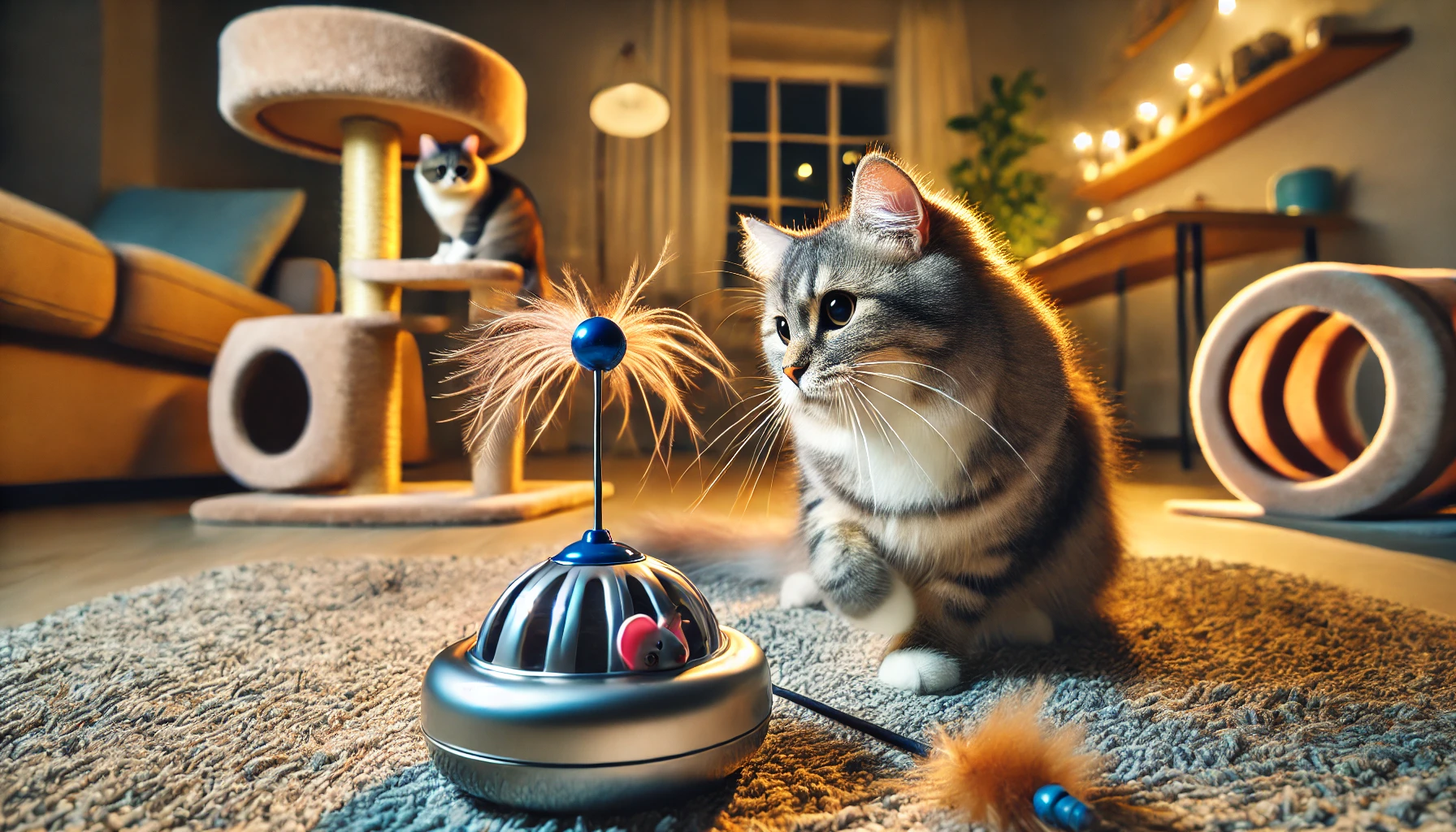
Interactive Toys: Keeping Your Cat Engaged
Interactive toys are designed to simulate the movement of prey, stimulating your cat’s hunting behavior.
Motorized and electronic toys are especially popular, with some of the best including self-moving, battery-operated mice or balls that challenge your cat to chase.
These toys are perfect for indoor cats who need to release energy and are great for independent play when you’re not around.
- Motorized toys mimic unpredictable movements, stimulating your cat’s natural hunting instincts.
- Interactive puzzle toys reward your cat with treats after solving a challenge, providing both physical and mental stimulation.
- Examples include motorized mice, laser pointers, and treat-dispensing puzzle boxes.
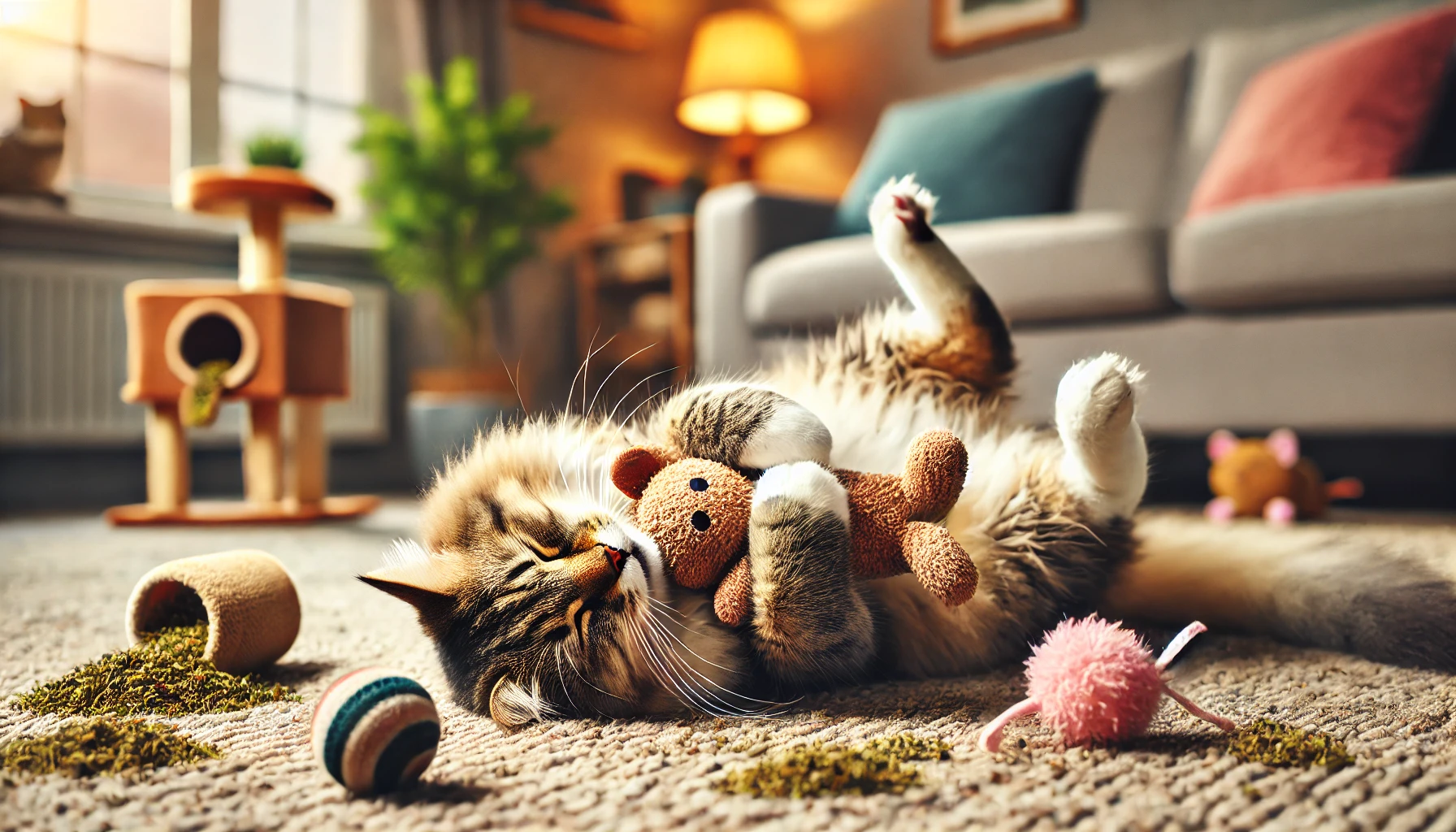
Catnip Toys: The Benefits and Fun
Catnip toys contain a natural herb that is irresistible for most felines.
These toys provide a lot of fun, stimulating your cat’s senses and making them more playful and active.
Your cat might spend hours playing with a stuffed mouse or plush animal filled with catnip.
However, not all cats respond to catnip, so it’s important to observe your cat’s reaction before investing in these toys.
- Catnip stimulates playful behavior and helps cats relax.
- Popular options include catnip-filled plush toys, kicker toys, and catnip balls.
- Not all cats respond to catnip—about 30% of cats show no reaction.
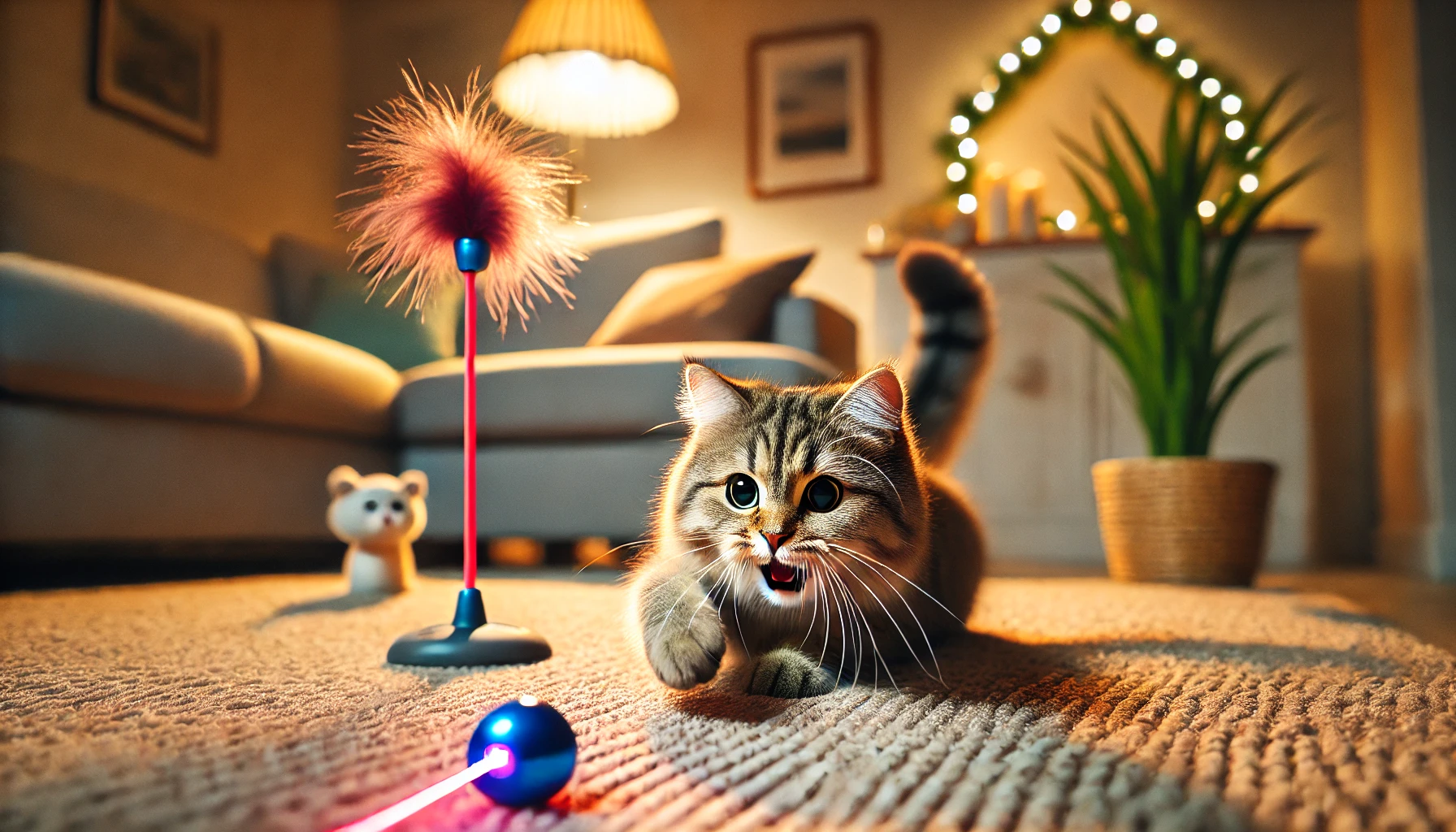
Feather and Laser Toys for Active Play
Feather wands and laser pointers are fantastic tools to get your cat moving.
Feather toys mimic the movement of birds, while laser pointers offer darting motions that drive cats wild.
Both encourage jumping, running, and pouncing, making them ideal for high-energy cats.
Always end laser play with a tangible reward to avoid frustrating your cat.
- Feather toys imitate birds, engaging your cat’s natural instinct to chase.
- Laser pointers stimulate predatory instincts through random movements.
- Reward your cat with a treat or toy after laser play to keep them satisfied.

Puzzle Toys: Teasing Your Cat’s Brain
Puzzle toys are excellent for cats that enjoy mental challenges.
Most of these toys hide treats in compartments that your cat must figure out how to access.
They offer great mental stimulation and encourage food-motivated cats to eat more slowly.
Puzzle toys are especially helpful for indoor cats, reducing boredom and preventing destructive behavior.
- Puzzle toys challenge your cat’s brain by hiding treats in compartments.
- They encourage problem-solving and help prevent overeating by slowing down food consumption.
- Examples include treat mazes and interactive food dispensers.
Select toys based on your cat’s personality and play style to keep them physically and mentally stimulated.
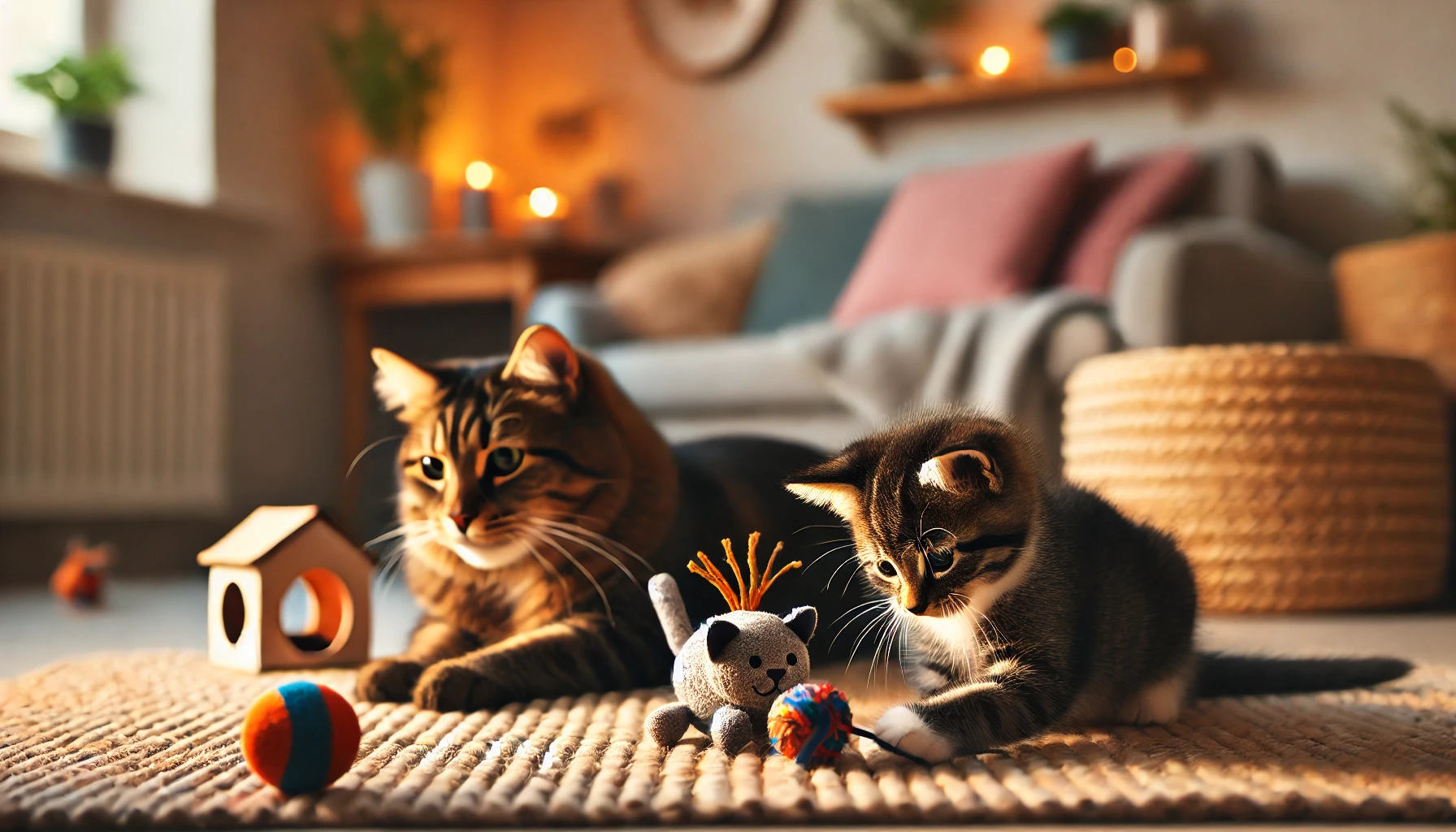
Choosing the Right Toy for Your Cat’s Age and Personality
All cats vary in their energy levels and personality traits.
These characteristics directly influence the type of cat toys your feline friend will enjoy the most.
Both age and personality play a significant role in determining which toy will best engage your cat.
Let’s explore how these factors help in choosing the purr-fect cat toys.
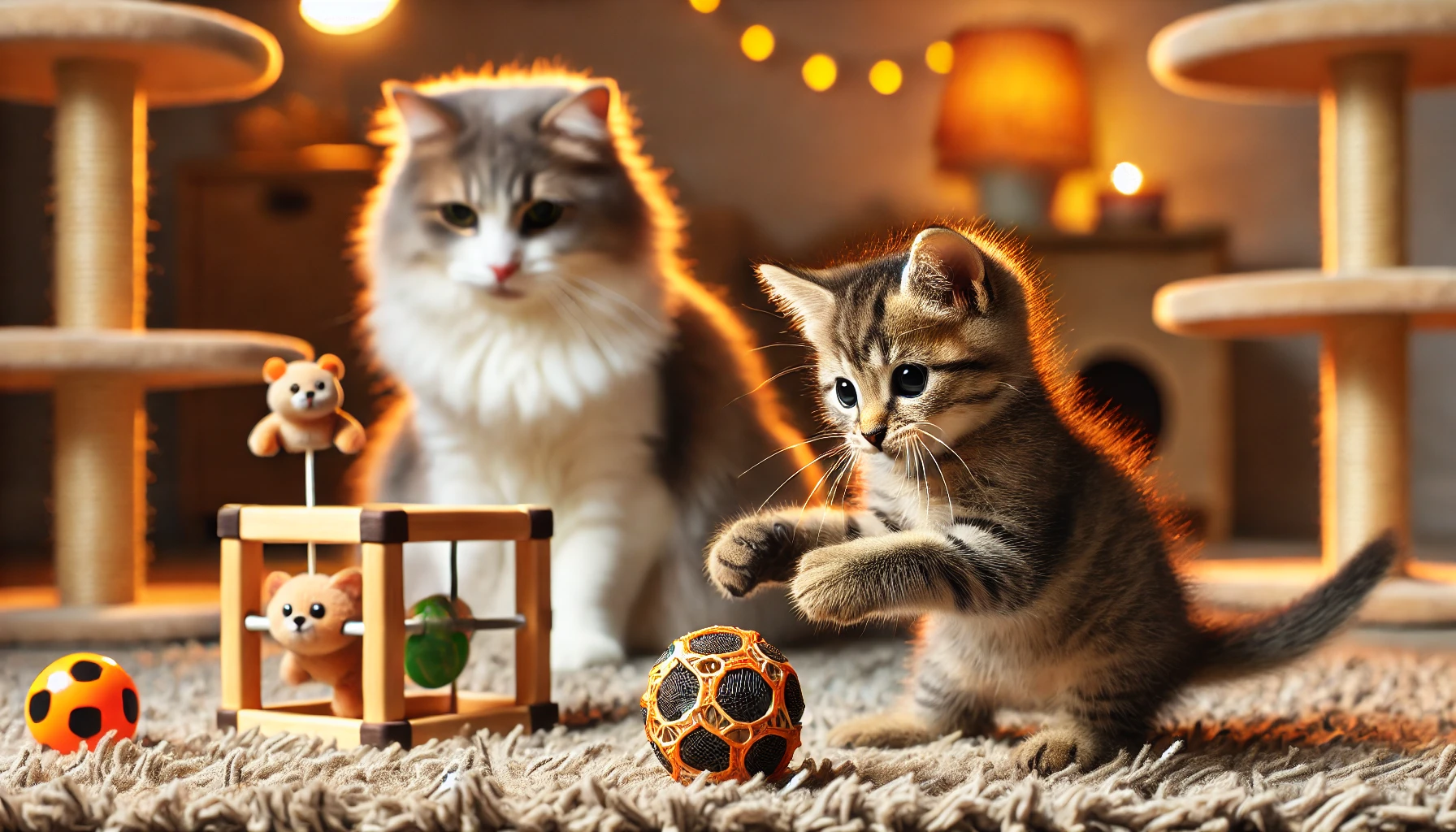
Play Needs: Kittens vs. Adult Cats
Kittens, being full of energy and curiosity, thrive on lightweight toys that are easy to bat around, such as crinkly balls or soft stuffed animals.
Toys with bells or feathers are also ideal as they tap into their natural hunting instincts and help them expend excess energy.
- For kittens, look for smaller, lighter toys like soft balls and crinkle toys that encourage chase-and-pounce play.
- Adult cats may prefer more complex toys like puzzle feeders or laser pointers, which stimulate their minds and allow them to engage their natural instincts.
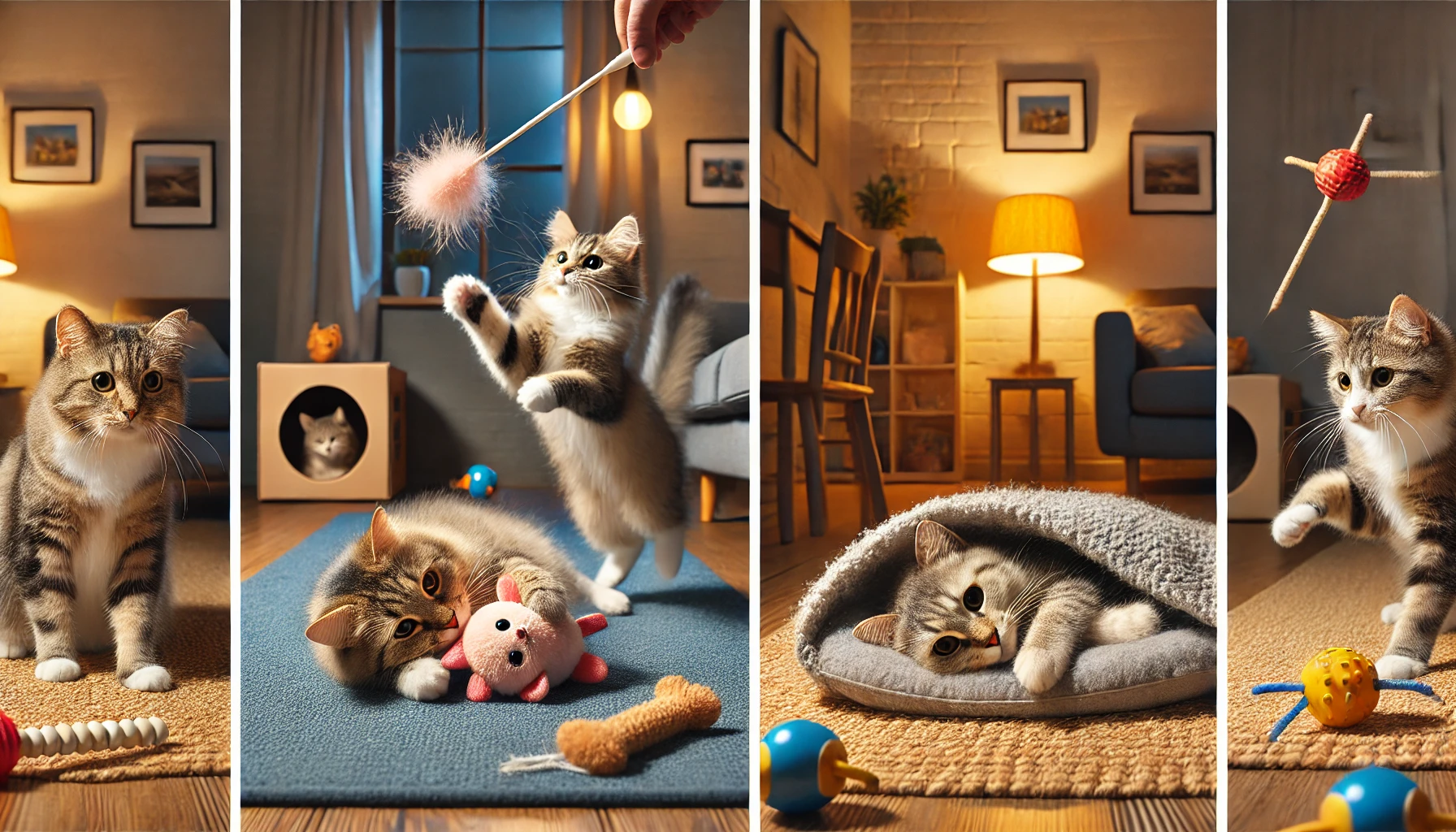
Toy Preferences Based on Personality: Shy vs. Active Cats
Just like humans, cats have different personalities.
An active, high-energy cat will enjoy toys that encourage movement, such as motorized toys or feather wands.
Meanwhile, a laid-back or shy cat might prefer soft, cuddly toys or those filled with catnip for comfort and relaxation.
- Energetic cats are drawn to high-energy toys like interactive laser pointers, fast-moving balls, or feather teasers.
- Shy or calm cats may prefer soft toys or catnip toys that they can cuddle with.
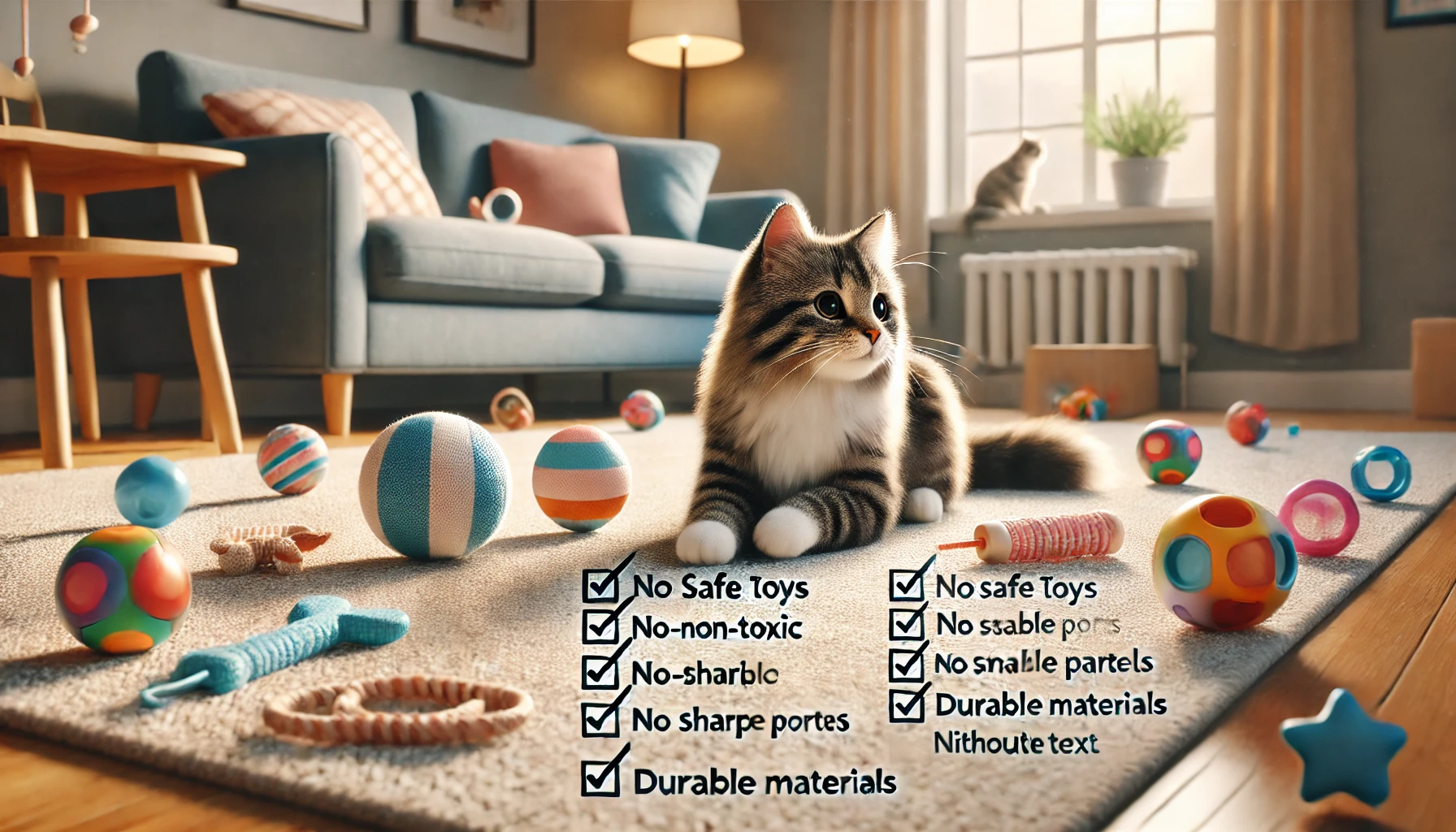
Safety Tips for Choosing Cat Toys
No matter your cat’s age or personality, safety is always a top priority when selecting cat toys.
Avoid toys with small parts that could break off or sharp edges that might harm your cat.
Opt for durable, non-toxic materials that can withstand rough play.
- Avoid cheap plastics or toys with long threads that could pose choking hazards.
- Regularly check your cat’s toys for wear and tear, and discard any damaged toys to prevent accidents.
Consider your cat’s age and personality to find the perfect toy that matches their energy level and interests.
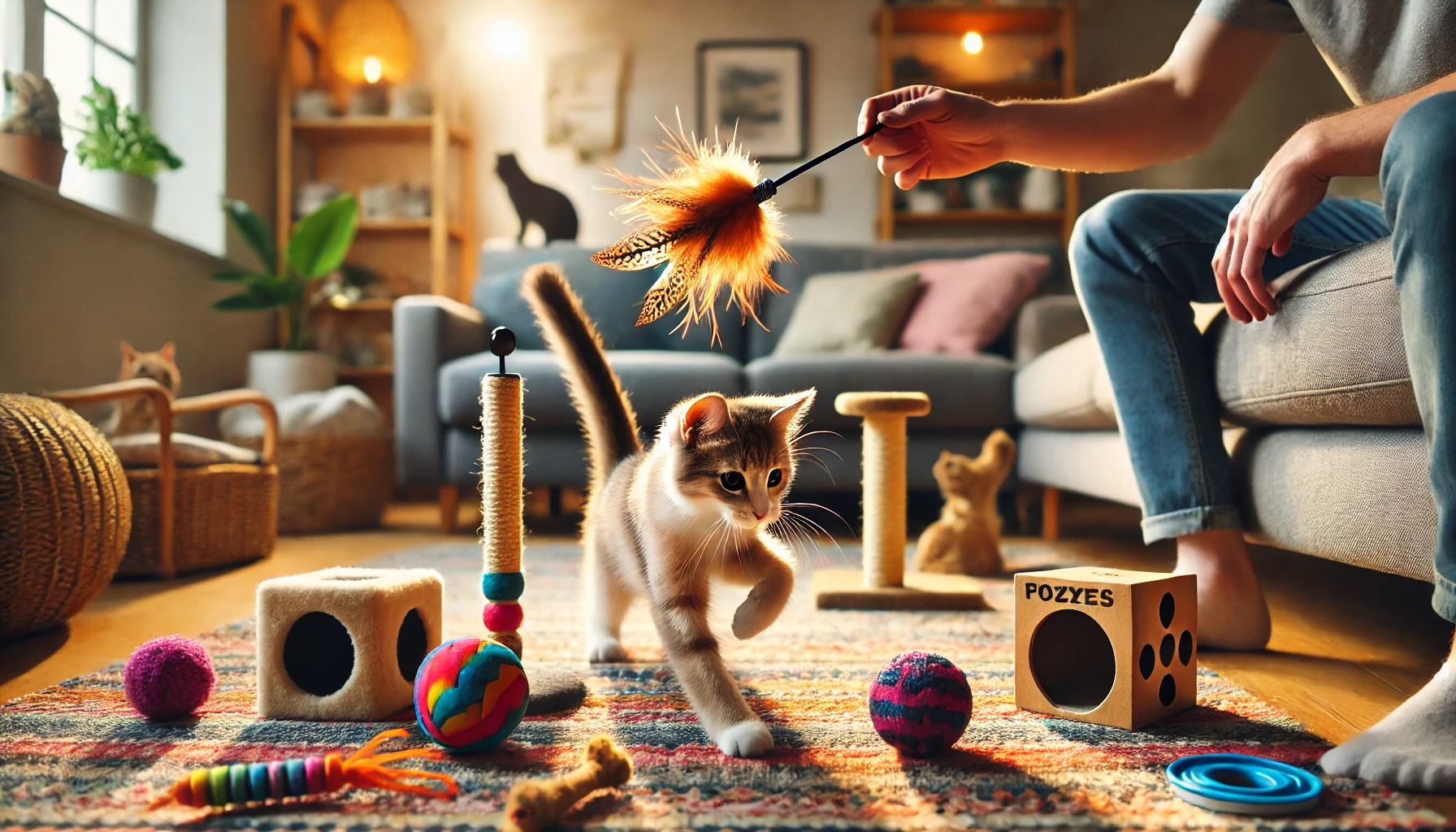
How to Keep Your Cat Interested in Their Toys
Cats can get bored with the same old toys after a while.
However, keeping your feline friend mentally and physically engaged is easier than you might think.
By regularly rotating their cat toys, introducing different types of play, and involving yourself in the fun, you can keep them interested at playtime.
Let’s explore some effective ways to maintain your cat’s interest in their toys.

Rotating Toys to Keep Them Interested
One of the easiest ways to keep your cat engaged is by rotating their toys.
Instead of leaving all toys out at once, introduce new ones every few days or weeks.
This method keeps things fresh and stimulates their natural hunting instincts by mimicking the experience of encountering different prey.
- Rotate toys every week or two to maintain novelty and prevent boredom.
- Store some toys away and reintroduce them later to make them feel ‘new’ again.

Combining Different Types of Play
A combination of physical and mental activities is key to keeping your cat engaged.
From puzzle toys that challenge their minds to feather wands that simulate prey, different types of toys offer varied stimulation.
Each type of toy taps into a different instinct, such as hunting or problem-solving, ensuring your cat stays entertained.
- Puzzle toys challenge your cat’s brain, rewarding them with treats for solving problems.
- Interactive toys like laser pointers and feather wands encourage chasing and pouncing, mimicking prey movements.
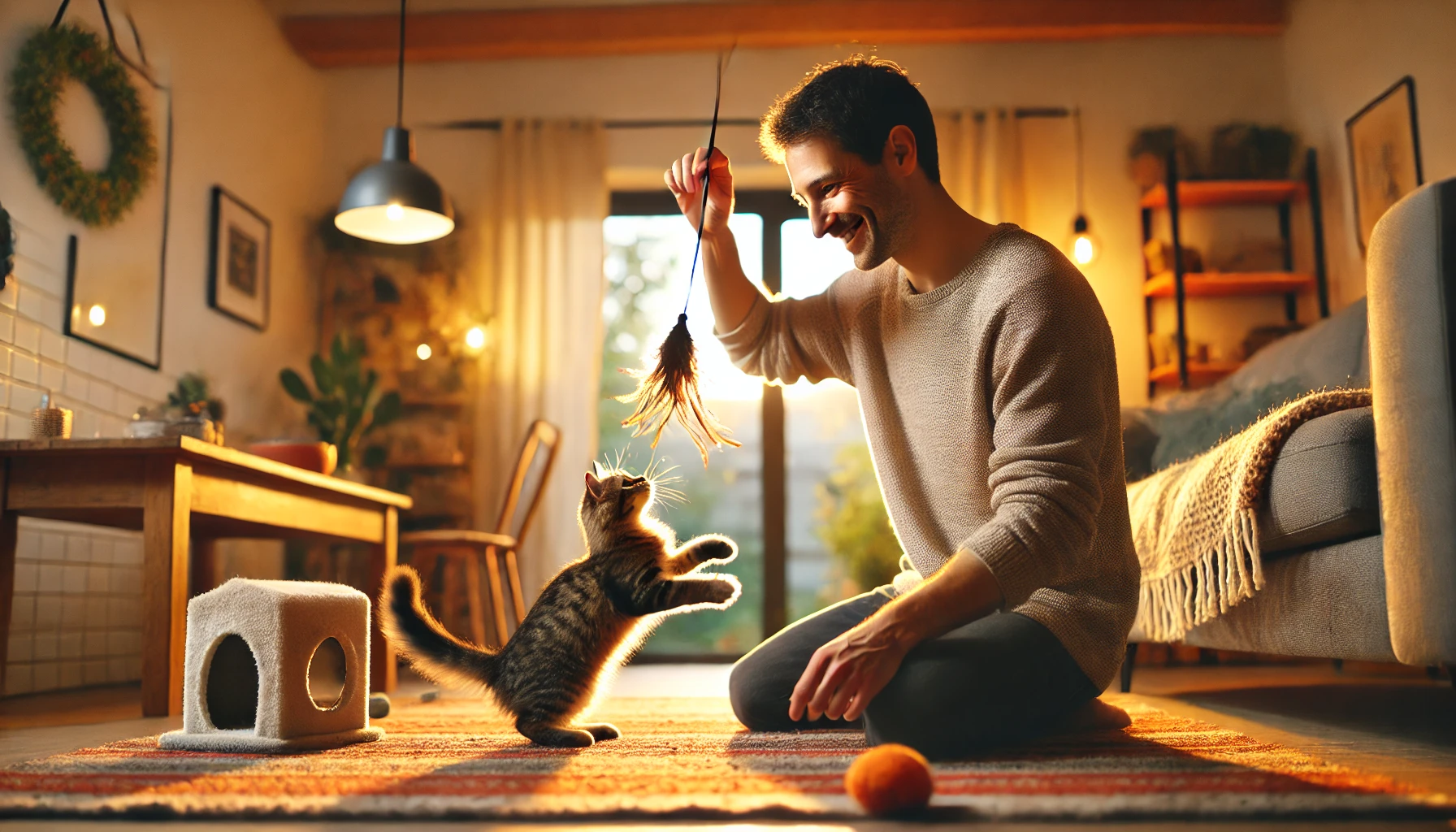
Incorporating Human Interaction for Better Engagement
While self-play is important, cats also crave social interaction.
Toys like teaser wands or balls you can toss not only keep your cat stimulated but also strengthen the bond between you.
Regular interactive play helps prevent your cat from getting bored and establishes a routine they’ll look forward to.
- Set specific playtimes to engage with your cat, building a stronger bond while keeping them active.
- Use toys like feather wands or balls to play directly with your cat.
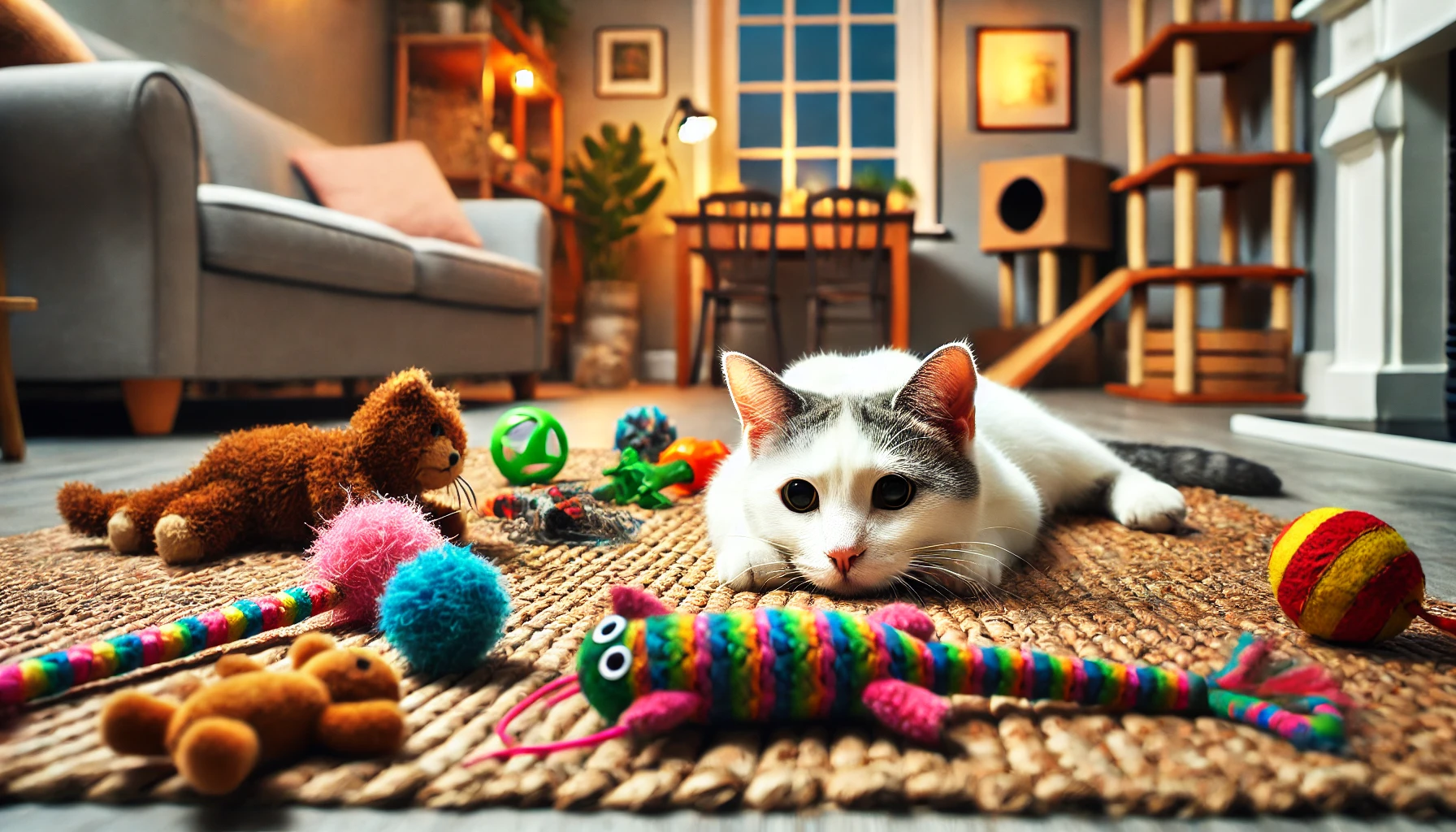
Signs Your Cat Needs New Toys
If your cat becomes indifferent to their toys or starts displaying destructive behavior, it might be time to rotate their toys or introduce new ones.
Pay attention to their behavior during playtime to gauge when it’s time for a change.
- Look for signs of boredom, such as ignoring toys or engaging in destructive actions.
- Mix up their toy routine by adding new types of toys, like treat-dispensing puzzles or motorized toys.
Regularly rotate toys, introduce new play types, and engage with your cat to keep them interested and active.
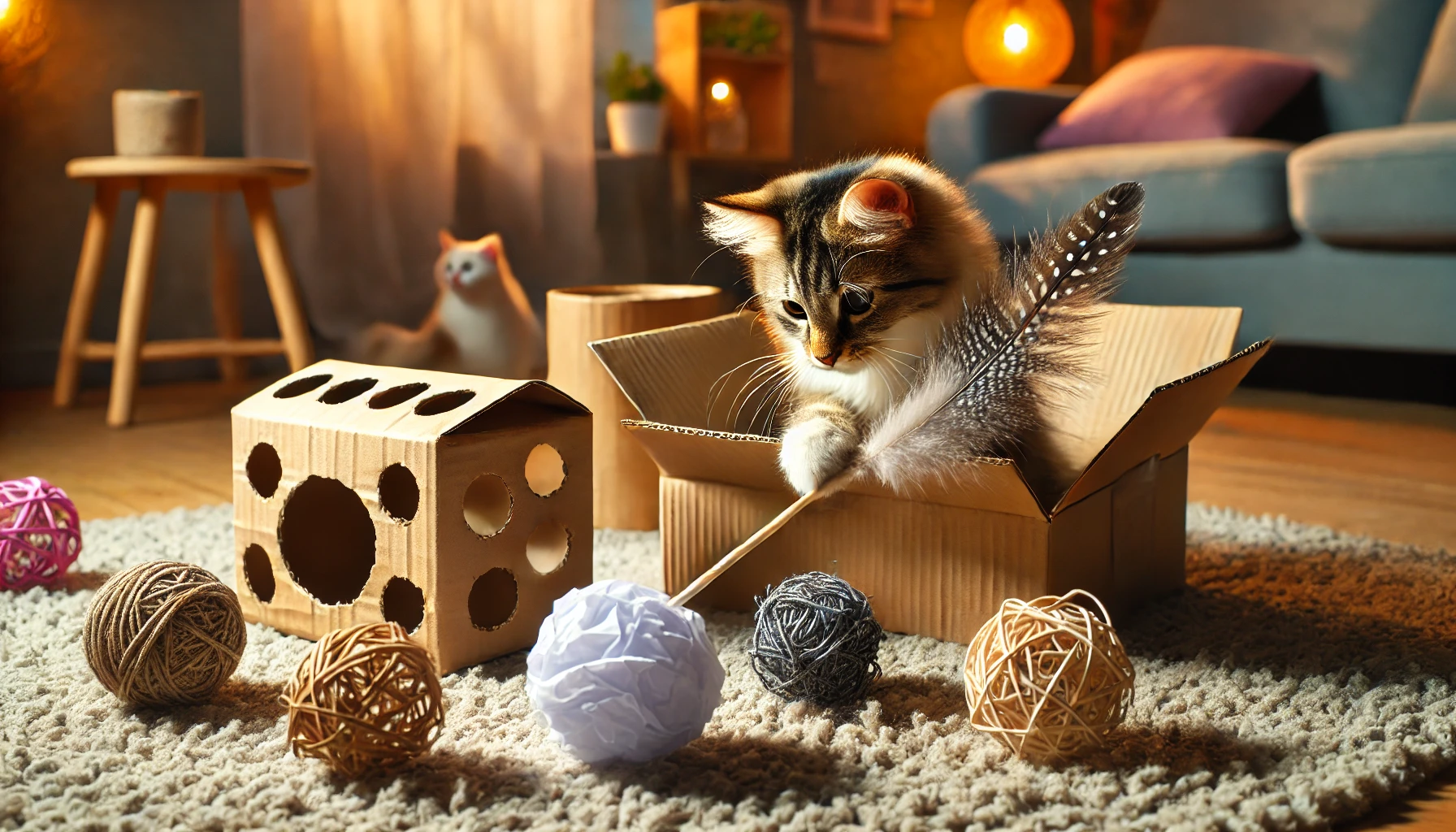
DIY Cat Toys: Cheap and Entertaining Ways
Homemade cat toys are not only budget-friendly but also carry a personal touch that your kitty will surely love.
These toys can be made from simple household items, turning everyday objects into interactive and engrossing experiences for your feline friend.
Additionally, DIY toys allow you to customize them based on your cat’s preferences.
Let’s explore some fun, easy, and safe DIY cat toy ideas.
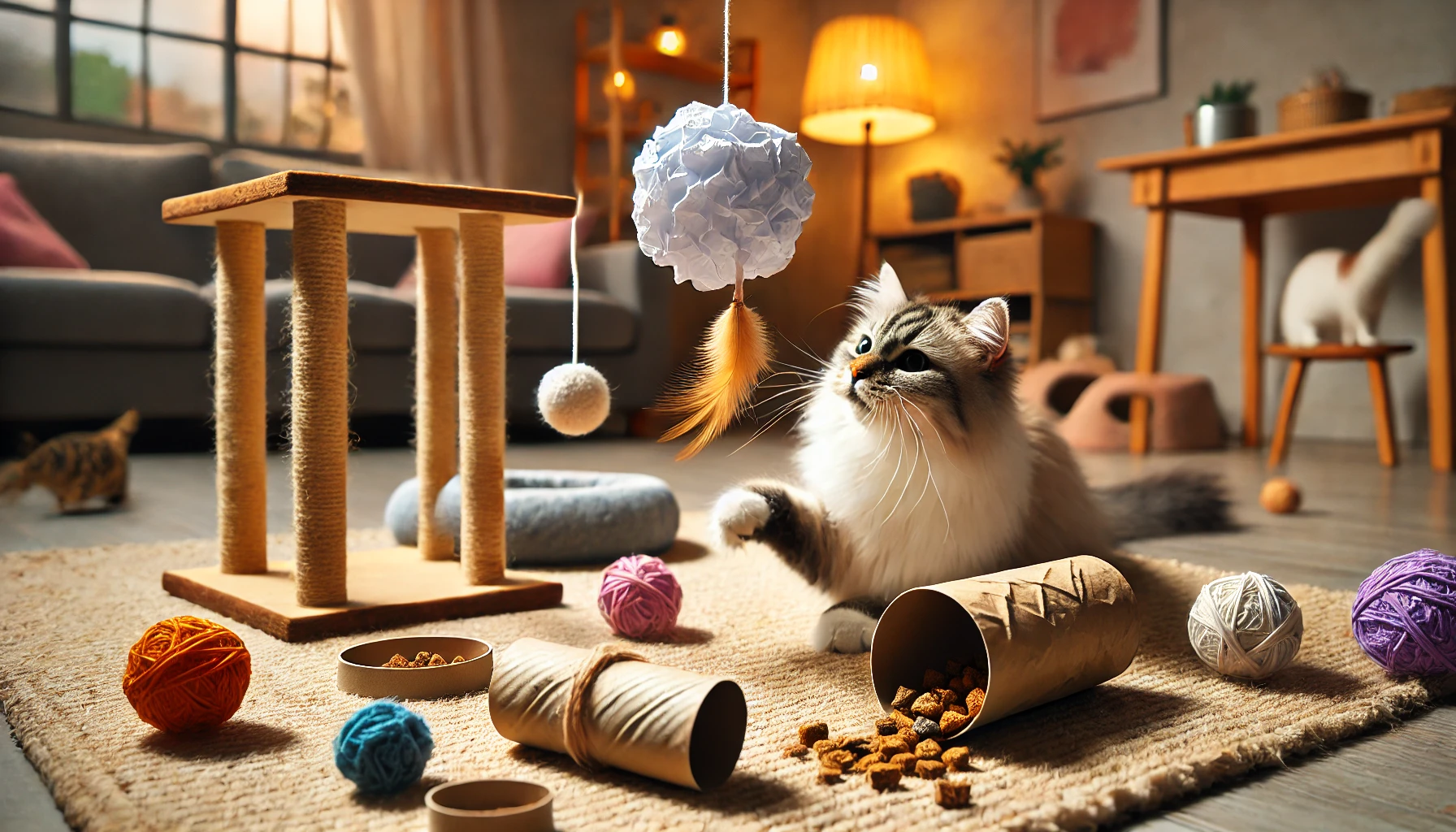
Creating Simple Toys with Household Items
Many everyday household items can be used to create toys that will keep your cat entertained for hours.
For example, crumpled paper or an empty toilet paper roll can provide endless fun.
You can also make a cardboard hide-and-seek puzzle by cutting holes into a cardboard box and placing treats or small toys inside.
These toys are easy to make but highly effective in keeping your cat engaged.
- Crumple up paper into a ball for a quick, safe toy.
- Use empty toilet paper rolls to create easy puzzle toys.
- Make a cardboard hide-and-seek toy by cutting holes in a box and hiding treats inside.

Safety Tips for Homemade Toys
Whenever making DIY cat toys, safety should always be your top priority.
Use non-toxic materials and avoid small parts that could pose a choking hazard.
Feathers, strings, and bells are attractive to cats, but ensure they are securely fastened to prevent ingestion.
Always supervise your cat while they are playing to ensure they stay safe.
- Use non-toxic materials like cotton, cardboard, or fleece.
- Avoid small, detachable parts that could be swallowed.
- Supervise your cat while they play with homemade toys to avoid accidents.
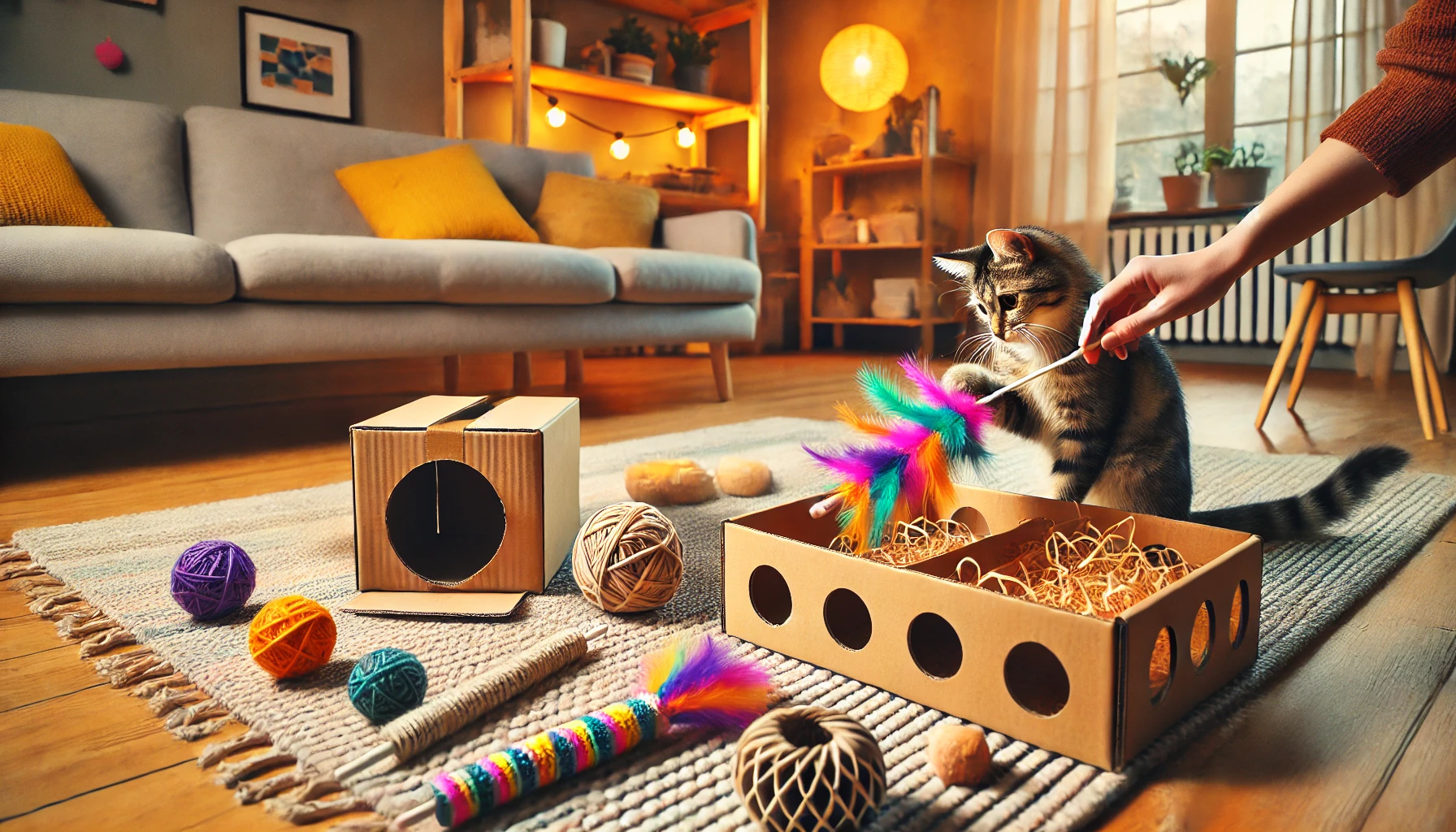
Homemade Toys to Entertain Your Cat
If your cat enjoys interactive play, you can create toys that stimulate their hunting instincts.
A DIY feather wand, for example, can be made by attaching a feather to a string and tying it to a stick.
You can also create puzzle feeders using recycled materials like cardboard tubes to challenge your cat’s mind as they work to retrieve treats.
- Make a feather wand by tying feathers to a string and attaching it to a stick for interactive play.
- Create puzzle feeders by hiding treats inside paper rolls or small boxes.
- Increase engagement by adding elements like bells or crinkling paper to stimulate your cat’s curiosity.
Homemade toys can be fun and budget-friendly, but ensure they are safe and engaging for your cat.

Conclusion: Knowing Cat Toys for a Happy, Healthy Feline
Variety in daily life is crucial when it comes to cat toys for your pet.
Each toy serves a specific purpose—whether it’s expressing their natural hunting instincts, preventing boredom, or curbing unwanted behaviors.
Choosing the right toys based on their age, personality, and preferences keeps them stimulated and content.

Importance of Rotation and Interaction
As we discussed earlier, regularly rotating your cat toys keeps your cat engaged and makes playtime exciting.
Whether it’s puzzle feeders, feather wands, or crinkle balls, variety is what maintains your cat’s interest.
Interactive playtime between you and your cat not only strengthens your bond but also promotes a healthier lifestyle for your feline companion.
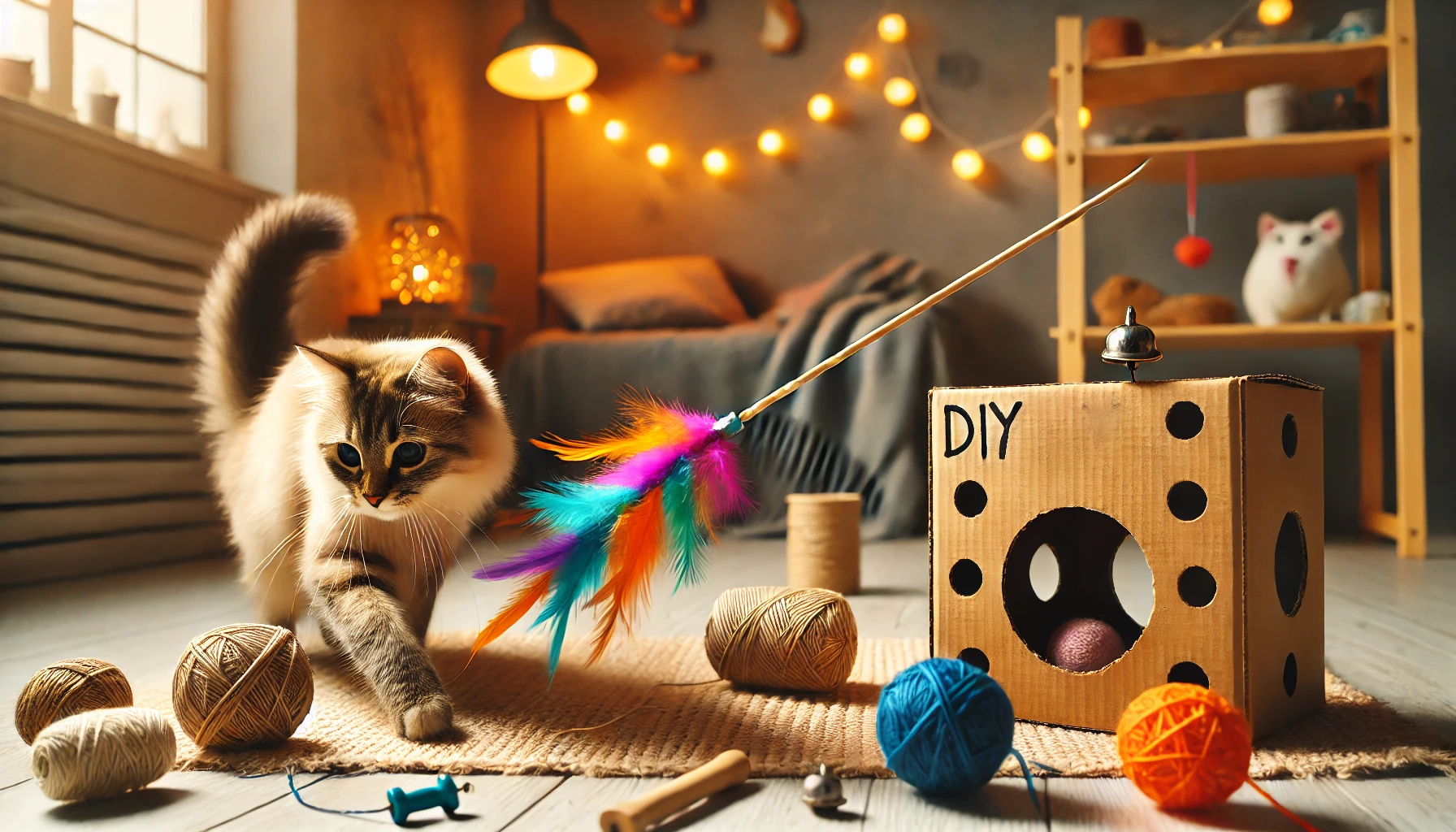
DIY Cat Toys: Budget-Friendly Personalized Options
Making your own cat toys is a great way to personalize your cat’s playtime while saving money.
With non-toxic materials and a bit of creativity, you can craft toys that are just as enjoyable as store-bought options.
Always ensure that the materials used are safe and avoid small parts to prevent choking hazards.
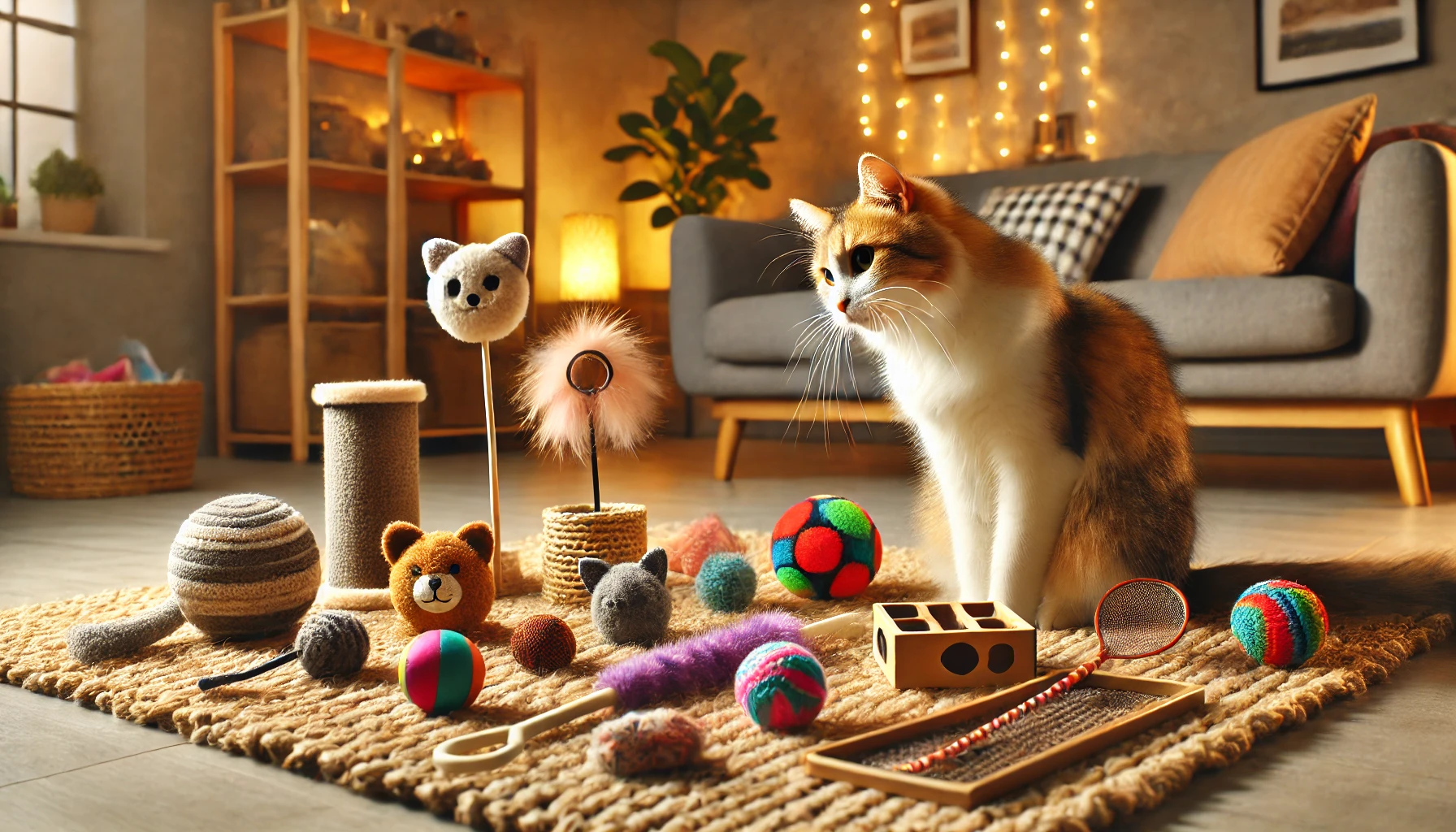
Choosing the Right Toy for Your Cat
From playful kittens to laid-back adult cats, the variety of cat toys available caters to every mood and personality.
Interactive toys that stimulate your cat mentally or simple DIY toys that spark their curiosity can significantly impact their happiness and overall well-being.
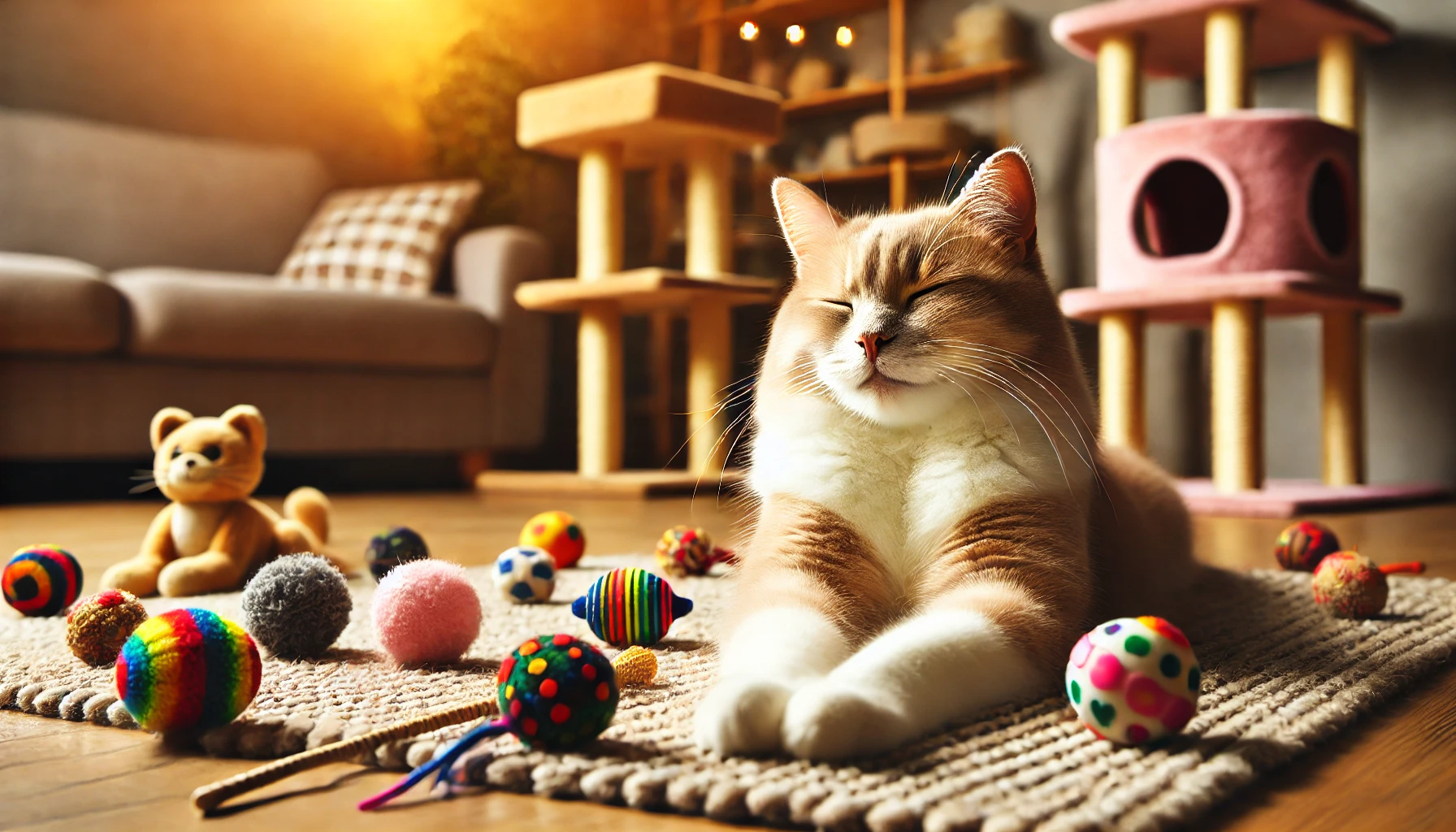
Final Thoughts
By understanding the importance and role of cat toys in keeping your feline healthy, you can create an enriching environment that keeps them physically active and mentally alert.
Whether store-bought or creatively homemade, the goal is to ensure your kitty remains engaged, happy, and healthy each day.
Variety and interaction are key to keeping your cat healthy and entertained, whether with store-bought or DIY toys.
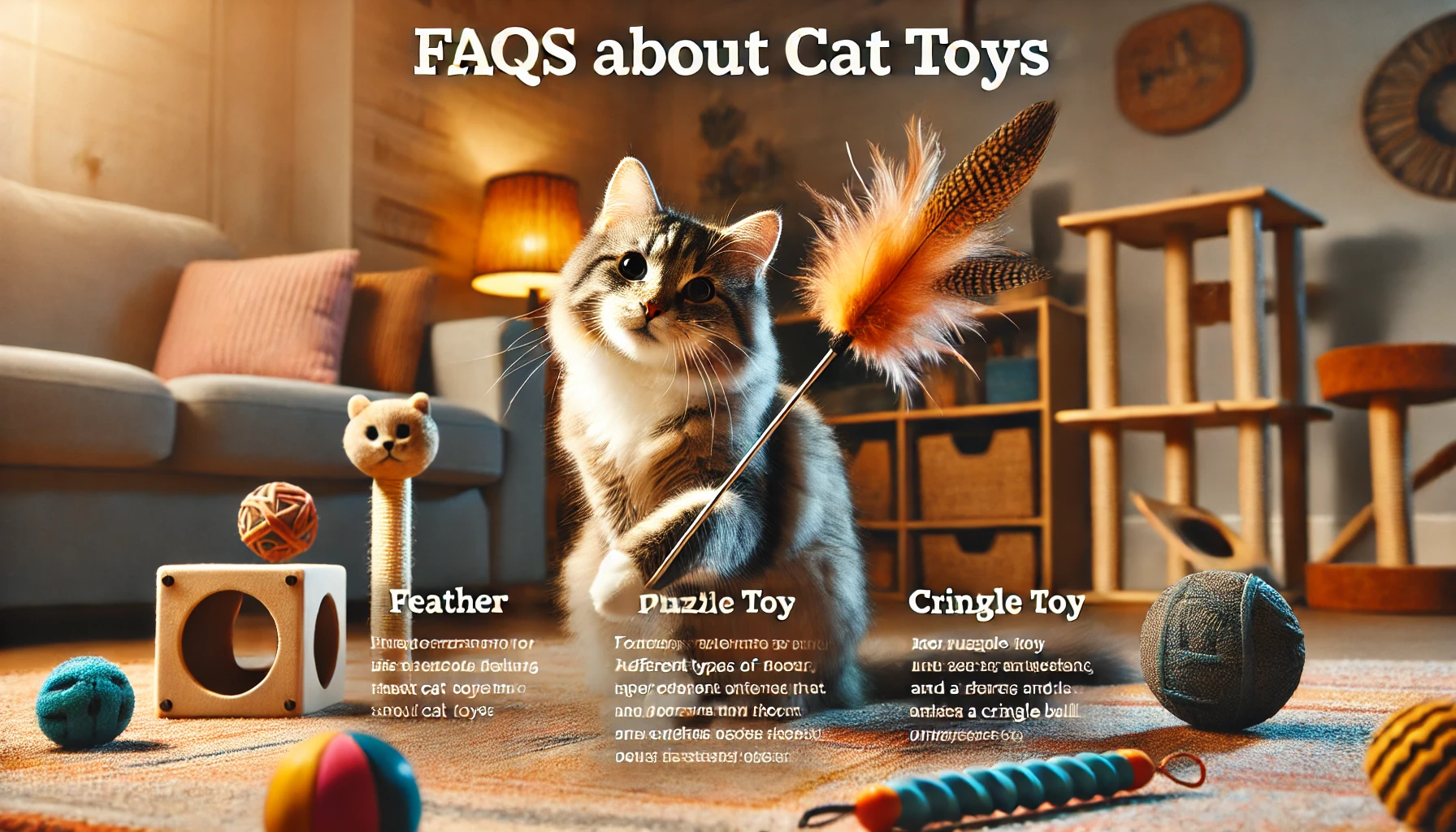
FAQs About Cat Toys
Why are cat toys important for my cat's health?
Cat toys keep your cat physically and mentally active.
They allow your cat to express their natural hunting instincts, prevent boredom, and reduce the risk of destructive behaviors such as scratching or biting.
How often should I rotate my cat's toys?
Ideally, you should rotate your cat’s toys every week or two to keep things fresh and engaging.
This way, your cat won’t grow bored with the same toys and will stay interested and happy during playtime.
Are homemade cat toys safe to give to my pet?
Homemade cat toys can be safe if you use non-toxic materials and avoid small parts that could pose a choking hazard.
Always supervise your cat while they are playing to ensure safety.
What are some good toys for kittens?
Kittens love lightweight toys like crinkly balls, soft stuffed animals, and feather wands.
These toys help develop their motor skills and hunting instincts while providing plenty of fun.





